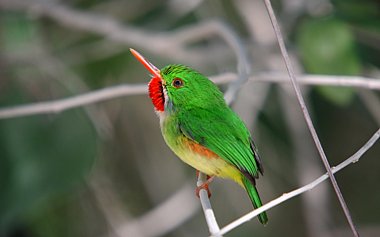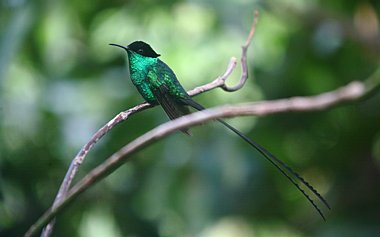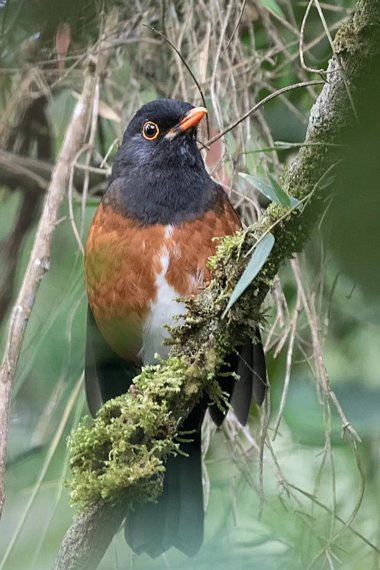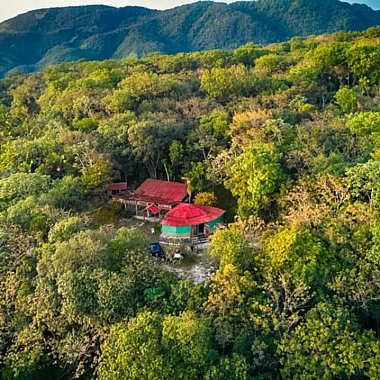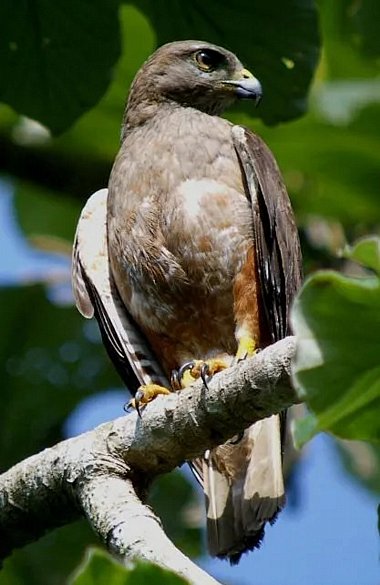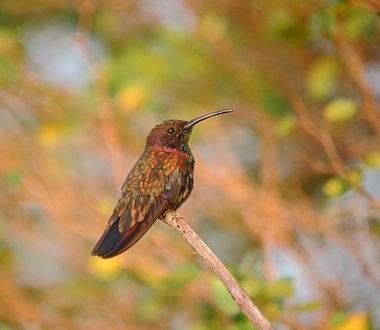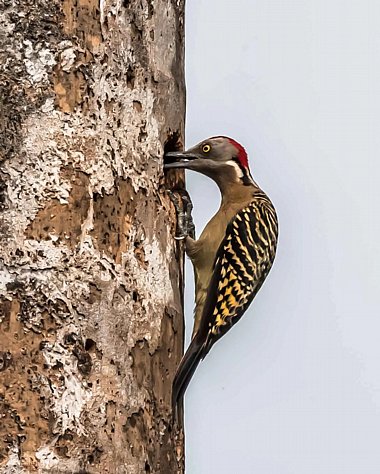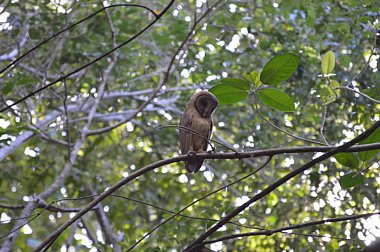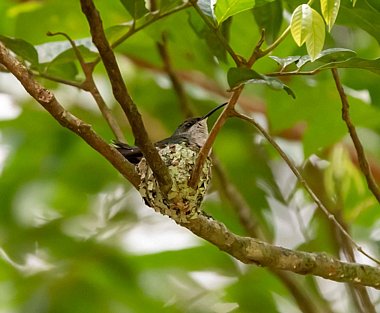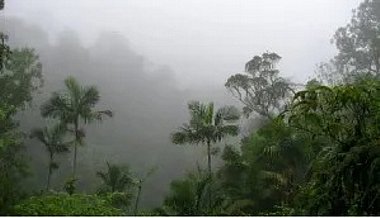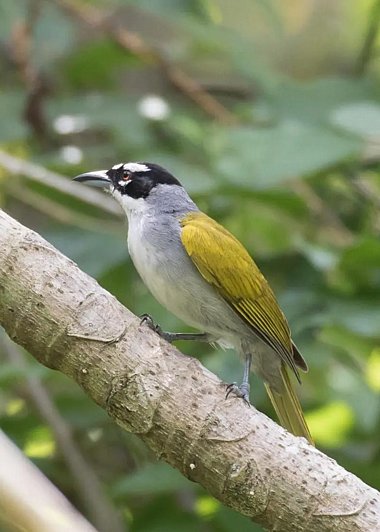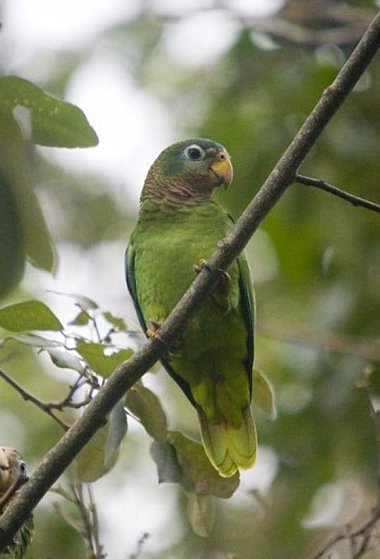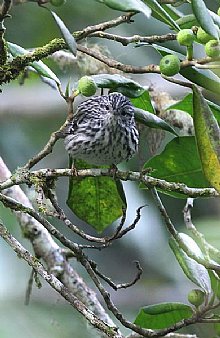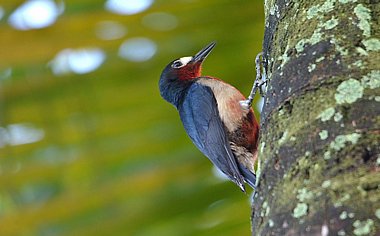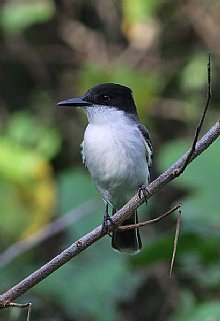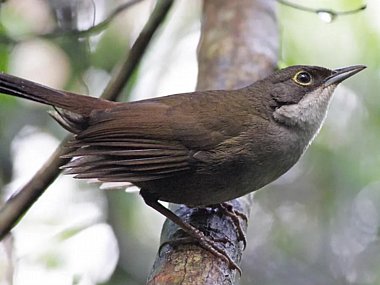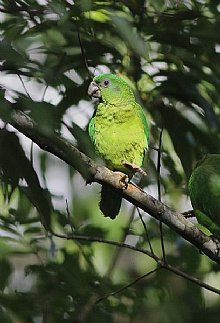NEW! Jamaica, Dominican Republic and Puerto Rico
A Greater Antilles Adventure - three islands and an endemic filled tour!
| Destinations | |
|---|---|
| Focus | |
| 2027 Dates | |
| Duration | 14 Days |
| 2027 Price | Guide price £8795 pp £795 single supplement. Deposit £1200 pre-flight airport hotel and lounge are inc. |
| Max Group Size | 8 |
- Free Bird Guide
FREE copy of Birds of the West Indies with every room booked on this holiday.
- Enquire
On this epic multi-island adventure, we travel to three spectacular countries in the Greater Antilles chain. The chance to visit just one of these offers vast birding potential, but with the rare opportunity to explore Jamaica, Dominican Republic AND Puerto Rico on the same tour, for birders this is a dream come true. With a maximum group size of just 8 on this tour and with two guides on hand, we should really be able to maximise our time in each destination, hopefully achieving an enviable bird list!
We begin in Jamaica, where we travel around the country and have every opportunity to encounter a large percentage of the 28 single-island endemics. Jamaican Blackbird is a key target in the Blue Mountains, as are range restricted Black-billed and Yellow-billed Parrot. The Dominican Republic is next, the largest country we visit spanning two-thirds of the island often known as Hispaniola (shared with Haiti to the west). It is home to the largest variety of birds and the most diverse habitats, including Lake Enriquillo, the largest internal waterbody in the Caribbean. Of the mouth-watering 32 single-island endemics, Ridgway’s Hawk, Hispaniolan Parrot, Hispaniolan Trogon, Hispaniolan Palm and White-necked Crow are among our targets. We spend more time here than our other two destinations, and in doing so make a real effort for difficult, high montane forest species including La Selle Thrush, White-winged Warbler and Western Chat-Tanager. We should also enjoy a good variety of birdlife from passage waders to wintering North American Wood-warblers. Our final destination is Puerto Rico, home to a further 18 single-island endemics including the iconic Puerto Rican Parrot, Puerto Rican Tody, Puerto Rican Lizard-Cuckoo, rare Elfin Woods Warbler and plenty more!
With such a wealth of possibilities and opportunities to see new birds around every corner, this is one of most exciting new tours on offer with Heatherlea!
Enjoy your complimentary pre-flight overnight hotel before your holiday begins. Full details from our office! Read more about our Pre-flight Service here!
Day 1: Wed 27 January 2027 – Travel to Jamaica
We fly from Heathrow to Jamaica, and upon our arrival in Norman Manley International Airport near the capital city of Kingston, transfer to our hotel in Port Royal where we stay for our first night. There may be time for a little pre-dinner birding too.
Day 2: Thur 28 January – Blue Mountains, Jamaica
With 28 single island endemics, Jamaica is a great island to begin our tour as is the Blue and John Crow National Park, our first destination. Designated a World Heritage Site in 2015, we ascend into the Blue Mountains, a spectacular haven for birdlife with half of our target birds possible on our very first day! Exploring the famous bird highway of Hardwar Gap about halfway up towering Blue Mountain Peak, threatened Jamaican Blackbird (in its own genus Nesopsar) is a key target. We also search for Crested Quail-Dove, a difficult species often located by its haunting song earning it the local nickname ‘mountain witch’. Other likely species include Chestnut-bellied Cuckoo, Jamaican Lizard-Cuckoo, Blue Mountain Vireo, Jamaican Mango, Jamaican Elaenia, Rufous-tailed Flycatcher, Jamaican Vireo, Jamaican Woodpecker, Jamaican Tody and stunning Red-billed Streamertail - endemic to Jamaica and also the island’s national bird. A great first day in the field, and after dinner we may have another try for nocturnal species again if desired. Overnight in the Blue Mountains for a single night.
Day 3: Fri 29 January – Buff Bay River Valley, Jamaica
After a leisurely breakfast we spend a little more time in the local cloud forests with Jamaiaan endemics at the fore. Priority targets include Jamaican Spindalis, Arrowhead Warbler, White-chinned and White-eyed Thrush, and we hope to find shy Rufous-throated Solitaire (of the endemic subspecies solitarius). With our targets found. travelling northeast we enter the scenic Buff Bay River Valley to the north coast parish of Portland. New endemics are likely to include Orangequit, Jamaican Becard, Jamaican Pewee, Jamaican Oriole, Sad Flycatcher and Ring-tailed Pigeon, along with near-endemic Greater Antillean Elaenia and Vervain Hummingbird. We stay at Portland for one night.
Day 4: Sat 30 January– Ecclesdown Road, Jamaica
White-tailed Tropicbird are one of the most beautiful and iconic of Caribbean seabirds, and we make an early morning visit to appreciate their aerial acrobatics. Always a good way to start to any day in Jamaica, we then move on to one of the most prolific sites for endemics – the much-famed Ecclesdown Road. Focused on finding new species, Black-billed Parrot, Jamaican Crow, Large Jamaican and Small Jamaican Elaenia and range restricted Black-billed Streamertail all being key endemics, with a number of other species likely in this bird-rich area. In the afternoon, we expect to have time to look for any unseen birds or try for better views of desirable species such as Jamaican Spindalis or Red-billed Streamertail. After dinner, (if we have not already done so) we can head out dark as we search for nocturnal dwellers including Chuck-will’s Widow, Northern Potoo, Jamaican Owl and American Barn Owl (of the furcata subspecies).
Day 5: Sun 31 January - Transfer to Dominican Republic
Today we depart Jamaica, but not before we spend some time looking for endemic Yellow-billed Parrot. Also possible this morning is Olive-throated Parakeet, before we make our way to the airport for our flight to the Dominican Republic. We stay close to the Santo Domingo area for one night.
Day 6: Mon 1 February – West Dominican Republic endemics
The Dominican Republic offers some of the best birding in the Caribbean, boasting 32 single-island endemics, alongside a number of Caribbean specialities as well as passing migrants. At a quiet oasis close to our hotel, likely are Hispaniolan Woodpecker, Black-crowned Palm-Tanager, Broad-billed Tody, Hispaniolan Mango, Hispaniolan Lizard-Cuckoo and Palmchat – an unusual communal nester. Also possible are Vervain Hummingbird, a near endemic thought to be the world’s second-smallest bird, plus American Kestrel (of the Hispaniolan form), Antillean Palm-Swift, Red-legged Thrush and West Indian Whistling-Duck.
Being larger than other islands, habitats are more varied in the Dominican Republic and today we have the opportunity to explore salt pans, dunes, mangroves and Lake Enriquillo – the largest internal waterbody in the Caribbean. Hispaniolan Palm Crow is a scarce endemic and key target, while also possible are endemic White-necked Crow and Hispaniolan Parrot, plus American Flamingo, Roseate Spoonbill, Greater Antillean Bullfinch, Greater Antillean Grackle and globally scarce Plain Pigeon. The mixture of habitats often proves attractive for migrants and as well as key endemics we have chances of a host of passing waders, seabirds and over-wintering passerines including Northern Waterthrush, Blackpoll, Prairie and other attractive American Wood-Warblers.
Day 7: Tue 2 February – Birding in the low elevation forests, Dominican Republic
Entering the foothills of the mountains, it is the forests on the slopes where we aim to find a number of new endemics. Targets include Hispaniolan Trogon, White-fronted Quail-Dove, Hispaniolan Spindalis, Antillean Siskin, Hispaniolan Pewee, near-endemic Golden Swallow, Scaly-naped Pigeon, Rufous-throated Solitaire and Antillean (Hispaniolan) Euphonia. We visit a reliable site for Eastern Chat-Tanager which can be a tricky bird to find, and also a narrow strip of riparian habitat where targets include endemic Hispaniolan Oriole, Broad-billed and Narrow-billed Tody, as well as Bay-breasted Cuckoo, Antillean Piculet, Flat-billed Vireo and others. After a great day in the field, we transfer to a small, locally owned hotel near Duverge for the next two nights.
Days 8 & 9: Wed 3 & Thur 4 February – The Elfin (Mossy) Forests, Dominican Republic
To make the most of our visit and to see the greatest variety of birds in these unique habitats, we leave before dawn for a site deep in the heart of the forest. La Selle Thrush, White-winged Warbler and Western Chat-Tanager are difficult, key species and by making the effort we have a good chance to connect with all three. Also likely in the high elevation broadleaved forest are Hispaniolan Emerald, Green-tailed Warbler and Hispaniolan (Loggerhead) Kingbird, and heading further uphill and into the pines we look for endemic Hispaniolan Crossbill and Pine Warbler (of the Hispaniolan subspecies). After a hard-working morning in the hills, we enjoy a more relaxing afternoon birding in the surroundings of our eco-lodge. As dusk falls, we have the chance to add further special birds, perhaps including Hispaniolan Nightjar, Northern Potoo, Least Pauraque, Chuck-will’s-widow, Ashy-faced Owl and the Hispaniolan subspecies of Burrowing Owl.
With the benefit of a full day and a half at the eco lodge, we have the next morning to try for any unseen high-elevation specialists. Our second afternoon will be spent travelling east, with roadside birding stops on the way back to Santo Domingo, where we stay for our final two nights on the island.
Day 10: Fri 5 February – Ridgway’s Hawk, Dominican Republic
From our Santo Domingo base we head north to one of the last strongholds of one of the rarest raptors in the world – Ridgway’s Hawk! Critically endangered and confined to a relatively small protected area in the north-east, perhaps as few as 200 are thought to remain, its fragile population in freefall as a result of mass deforestation and hunting. With up-to-date information, and a little bit of luck we hope to see this special bird as we follow up on recent reports at known sites. The rest of the day will be spent trying to get better views of any endemics or desirable species in this part of the island. The Dominican Republic leg of our tour comes to its conclusion with a visit to an urban Hispaniolan Parakeet roost within the city.
Day 11: Sat 6 February – Exploring the Central and Eastern Puerto Rican forests
Leaving behind the large island of Hispaniola, we take a short hour-long flight to neighbouring Puerto Rico for our next adventure. The easternmost island in the Greater Antilles group, 18 species of bird are found nowhere else and within an hour or so of our arrival we find ourselves birding in the lush montane forests of the east, where Puerto Rican Tanager, Puerto Rican Woodpecker and rare Elfin Woods Warbler are a few of our primary targets, the latter a difficult, only recently described species requiring patience (and luck) for a good view. Other likely endemics include Puerto Rican Oriole, Puerto Rican Bullfinch, Puerto Rican Vireo, Puerto Rican Spindalis, Puerto Rican Emerald, Puerto Rican Tody, Green Mango. Another key target for the day is the critically endangered Puerto Rican Parrot. And we may get a sighting of Broad-winged Hawk (of the endangered Puerto Rican sub-species) soaring overhead. Before dinner at a local spot, we spend some time on the hunt for the Puerto Rican (Screech) Owl. We stay at Luquillo for one night.
Day 12: Sun 7 February – Western Puerto Rican specialities
With some key and difficult species to continue to search for, this morning we head back into the rainforest after a short stop at a reliable site for Puerto Rican Lizard-Cuckoo. Together with our key targets, we are likely to catch sightings of a number of attractive North American Wood-warblers such Cape May, Black-throated Blue and Black and White Warbler, Northern Parula and American Redstart in this verdant habitat. We then make our way south, where upon arrival, we try to find Yellow-shouldered Blackbird - often found opportunistically foraging for scraps around town! Finally, having worked our way to the dry coastal forests by nightfall, we try for Puerto Rican Nightjar before dinner and a well-deserved rest. We stay at Lajas for the last night of our Antilles adventure!
Day 13: Mon 8 February – Final birding and return to the UK
This morning, we head out early, making our way north to one of the largest tracts of native woodland in the north of the island. These forests support a high proportion of islands endemics and we should be able to mop up any remaining endemics and desirable Caribbean species not yet seen. On good trails we look for Lesser Antillean Peewee (of the Puerto Rican subspecies), Adelaide’s Warbler and Puerto Rican Flycatcher. Also likely are near-endemic Puerto Rican Mango, Loggerhead Kingbird (of the Puerto Rican subspecies taylori) and Mangrove Cuckoo. Critically endangered Puerto Rican Sharp-shinned Hawk is another target which may be seen soaring above us - an endemic subspecies (venator) which may soon be recognised as a full species. We will also have another shot at the Puerto Rican Parrot before we make our way back to San Juan, for our flights home. We expect to arrive back in the UK on Tue 9 February (day 14), with a long list of difficult, mouth-watering endemics in our notebooks!
Please note: all itineraries are given as a guide only. Actual holiday content may vary according to the judgement of your guide, and elements beyond our control (eg weather).
What's included in your holiday price:
- scheduled outbound flight from a London airport to Kingston, Jamaica and return flight from San Juan, Puerto Rico back to London. Internal flights between the three islands, airport taxes and transfers.
- all accommodation and meals, including breakfast, lunch and dinner. Some mealtimes will be eaten 'in the field'
- ground transportation as outlined.
- any reserve and park access fees
- the services of your leaders.
- The Heatherlea Pre-Flight Service offers everything you need at the airport, including hotels, car parking, airport lounges, regional flights, and upgrades. Let Heatherlea take the strain! Pre-flight airport hotel and lounge included subject to terms and conditions. Read more..
Free Field Guide! - Birds of the West Indies by Allan Keith et al (published by Helm 2020) is included in your holiday price. One copy per room booked.

What's not included in your holiday price:
- personal insurance, drinks and other personal expenses, visa costs where necessary, optional tips to local guides/other staff, and any other costs not specified as 'included'.
More holiday information:
Accommodation is in hotels or lodges with all rooms en suite. Some of the lodges are remote, and have simple-style rooms. All are spacious, have en-suite facilities, and are very comfortable to a good standard.
Food You can expect fresh local produce including meat, poultry and fish full of Caribbean flavour! Fresh local fruit and vegetables are usually available and very tasty too. Picnic lunches will be provided where necessary. Water is included, and we suggest bringing your own water bottle to be topped up. Vegetarian and other diets are welcome.
Walking is generally light/moderate, though there are some trails where a level of exertion is required. Walking in the Elfin Forests on Dominican Republic can be more challenging with some uphill trails, perhaps in poor condition in places but this is the only way to get to certain key endemics! You will need an average level of fitness for this holiday.
Weather will be mixed. Mostly the temperature will be warm, with the possibility of rain. In some locations the weather is hot and humid, in others hot and dry, and at altitude can be cool and wet.
Insects There are biting insects, though not usually as a major problem. You should bring insect repellent.
Group size is restricted to 8 clients maximum.
Flights are by scheduled airline, from a London airport. We may be able to offer flight arrangements from another airport and/or or quote without flights so you can make your own arrangements. If you wish to add an extension either before or after your holiday, please contact us and we will be happy to arrange this for you.
Other birding and wildlife holidays in Central America & Caribbean
- Costa Rica Classic Tour
- Costa Rica Classic Tour - PLUS!
- Costa Rica with Easy Walking
- NEW! Belize - Wildlife of the Yucatan Peninsula
- NEW! Costa Rica: Birding, Whales and wildlife during migration
- NEW! Cuba including Havana
- NEW! Lesser Antilles - A Caribbean Island Hopping Adventure
- NEW! Mexico - Oaxaca
- NEW! Panama
- NEW! Tranquil Trinidad
- Trinidad, Tobago and Saint Lucia
Why choose Heatherlea for your birding and wildlife holiday in the Americas?
Our overseas holidays are planned with care to offer great birding and wildlife, led by capable Leaders who really look after you. Every holiday is run the 'Heatherlea Way', and we hope our Overseas Adventures remind you of the quality and care so many of you enjoy in Scotland. That means rewarding and exciting days in the field, and good quality accommodation and meals, with a real flavour of the country we are visiting. Heatherlea always seek to include the personal touches that make all the difference.
Heatherlea holidays are not ‘dawn to dusk’ expeditions. Our less-intensive approach is ideal for those who want to relax whilst experiencing the best wildlife watching, and wherever possible we organise early or late activity on an optional basis. We also take sensible breaks when in very hot places and regular comfort breaks on every holiday whenever possible. All itineraries are planned carefully around the best wildlife opportunities, and you won’t miss out on memorable wildlife, whilst enjoying relaxed, informal days that are great fun.
The really important part of any wildlife holiday is the experience for you, our valued customer. Heatherlea invest in many things to offer you the best possible service;
- We have been organising birding and wildlife holidays for over 30 seasons, and have a highly experienced and capable office team. We also offer a telephone and email service outside normal office hours.
- Heatherlea overseas holidays have a maximum of 12 clients per trip, putting the emphasis on personal service, and helping you get the best possible experience.
- Our holidays often include things which others might invite you to pay yourself, for instance Departure Taxes and tips to hotels.
- All elements of our holidays are sold under our own licence, ATOL 6113. Under ‘Flight-Plus’ legislation it is a legal requirement of any tour operator to hold an ATOL licence for the supply of any overseas holiday where a flight is involved, if that holiday includes either overseas accommodation and/or car hire. It can be a criminal offence for an operator to book flights as part of a package without an ATOL licence. Heatherlea also hold full Tour Operator Insurance for your added protection.
- Heatherlea is your complete wildlife holiday provider. Our ‘Back Office’ team can organise all your pre-flight and other travel needs. Our specialists will help you book the right services, at the best price. Book holiday extensions through us, and your ATOL protection is extended further. We don’t charge extra for this service.
- Heatherlea is a limited company, registered in Scotland, and registered to pay VAT (applies to all holidays within the European Union).
Trip Reports
Coming Soon
- Free Bird Guide
FREE copy of Birds of the West Indies with every room booked on this holiday.
- Enquire

